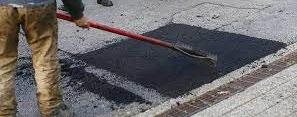4.6 Paving Materials
Related SPD sections
• Context
• 4.3 Green and Blue Infrastructure (including SuDS)
• 3.1 Equality, Accessibility and Inclusive Design
• 4 4 Microclimate and user comfort
Key City Plan policies

Context
43. A Public Realm
43. B An Inclusive and Accessible Public Realm
One of the overarching objectives of the NPPF is to protect and enhance our natural, built, and historic environment: using natural resources prudently, minimising waste and pollution, and mitigating and adapting to climate change, including moving to a low carbon economy.
The City Plan requires development to make use of high quality and durable materials capable of easy maintenance and cleaning, and the integration of high-quality soft landscaping as part of the streetscape design, using high quality new, or reinstated paving materials whose colour and texture underline a sense of place and consistency of materials and have an appropriately engineered surface that is fit for purpose.
Westminster is at the forefront of developing low-carbon highway schemes for widespread implementation. The City Council is committed to significantly reducing its carbon footprint with the use of carbon efficient materials, which are sustainably sourced, delivered, installed, maintained, and where possible reused at the end of a project’s life, to support the City Council’s ambition to be carbon neutral by 2030. This will be supported by the City Council’s Highways Carbon Management Plan 2024/5 62
Material choices for new public realm projects and maintenance schemes should consider the whole-life span of those projects, from material selection and sourcing, through to delivery, construction, operation, use, maintenance, end of life/removal and re-use.
The sustainable impact of materials is a crucial consideration for Westminster. With the climate emergency declared in 2021, it is imperative that materials, from their supply chain through to decommissioning, contribute positively to the environment.
The carbon impact of different modes of transport and fuel types should also be assessed, especially where heavy vehicles/machinery are not likely to be required. There is an option to reduce trips through consolidation and efficient planning of logistics, and to take any essential trips by sustainable travel modes.
Supply of materials should encourage use of sustainable fuels.
The weight of transported material should be reduced as far as practicable with reuse being promoted through careful specification as well as buying with takeback agreements.
All materials should adhere to:
NRSWA - New Roads and Street Works Act 1991 (legislation.gov.uk)
SRoH - Specification for the Reinstatement of Openings in Highways - Fourth edition (publishing.service.gov.uk)
62 Currently in development
The below guidance sets out the City Council's approach to material and paving choices, sourcing, implementation, operation, and, where appropriate, reuse in the public realm, and is to be used in assessing future proposals.
The principles of material choices are set out below. The appended Materials Palette (Appendix 2 – linked to below) identifies the recommended and accepted materials for use across the city and sets out their specific technical properties and suitable areas for their usage.
Paving Materials Overview Guidance
A. Paving materials should enable safe and efficient movement for pedestrians, cyclists, and vehicles.
B. The selection of materials and how they are laid should be appropriate to the context, both in terms of their appearance and functionality, thereby being fit for purpose in the longer term.
C. To ensure longevity and minimise carbon emissions throughout the project’s lifecycle, all chosen materials should comply with the standard technical requirements
D. Materials with limited functionality and / or high maintenance requirements should be avoided, especially when these are primarily proposed for aesthetic purposes.
E. Materials with a longer lead time of 4-5 months should be avoided.
F. All public realm design should seek to complement and seamlessly combine with the surrounding heritage infrastructure where applicable and complement and enhance the area where it is situated
G. Public realm design should be consistent across ownership, particularly where the public realm intersects and extends (in use) to privately owned land. Partnership working to achieve consistency is encouraged.
H. All designs should demonstrate value for money with respect to initial and operational environmental and economic costs.
I. The final design and materials selection of colour combinations should be consulted and agreed upon with the City Council on a case-by-case basis.
See appended Materials Palette Appendix 2 for detailed standards.
Functionality and Use
The intensity of use and associated wear of materials varies across the city. Footways in primarily residential areas generally sustain lower levels of wear in comparison to heavily trafficked commercial areas which require different treatments, maintenance, and cleansing regimes.
These requirements should be carefully considered in selecting the most suitable materials and construction technology in any public realm scheme.
Engineering judgement should respect minimum standards set out in the Materials Palette Matrix, aligned with the relevant design standards, and be applied for suitable locations. For example, when possible, the use of thinner slabs to minimise carbon is the general recommendation where light use is expected, but thicker slabs are required in areas likely to experience vehicle overrun is expected.
Material Selection for Functionality Guidance
A. Material choices should reflect the function and planned use of the space.
B. The materials and construction depths should be suitable for the planned purpose, based on thresholds, expected loading, and existing ground conditions.
C. The potential of structural material strengths should be optimised, avoiding under or over-designing the public realm.
D. All selected materials should be technically assessed to ensure their long-term durability with regard to maintenance, structure and function.
E. Over specification of materials is not supported where this would have negative environmental impacts.
F. Expected life of the material must be considered to ensure that the longevity of the scheme is maximised.
Providing a Healthy Environment
Material Selection for a Healthy Environment Guidance
G. Material selection and implementation should contribute to society as stated in the Healthy Streets for London guidance to make London's diverse communities greener, healthier, and more attractive places to live active lifestyles, work, play and do business within a safe and sustainable public realm.
H. Projects should aim to positively address local health and wellbeing by incorporating measures to lower emissions, reduce the harm caused by air pollution, and minimise acoustic impact, reducing noise levels.
I. Vegetation should also be considered as it reduces air pollution, provides a noise barrier to vehicle traffic, and reduces noise reflection while enhancing biodiversity and promoting wildlife.
J. Green and blue infrastructure, for example storm drainage, should be included where possible as these positively affect air and noise quality.
Materials Design:
Public realm design in the city should be simple at its core to avoid creating visual clutter and detracting from an already ‘information-rich’ streetscape. A simple palette of materials and colours coherent with the area’s character and use will ensure uncluttered-looking streets and public spaces.
When designing public spaces, the appropriate material choice, design and construction depend on: the townscape conditions and surrounding buildings, in addition to the intended use, any risks to maintenance and longevity, and the existing ground/environmental conditions.
Paving materials add to the attraction of character areas such as Covent Garden and Soho, which have a mix of building styles, where the relatively homogenous uniform paving helps create a sense of place, making it feel like a distinct area in its own right.
Piecemeal designs tend to segregate rather than unify the public realm and detract from the harmony within the city's built environment.
It is essential that all public spaces have a consistent design and that this is maintained throughout the area. The use of a limited palette will support the conservation of the city’s identity and guarantee consistent, high-quality maintenance and development of new schemes aligned with the city’s overall vision and commitments.
Materials Design Guidance:
A. Material design should be simple, coherent, and consistent.
B. Material choices should contribute positively to the surrounding built environment.
C. Any materials and design proposed should respond to the local context, for example, conservation areas, market places or character areas with high footfall, especially as different requirements may arise due to the specific function of a place.
D. New developments should consider materials and designs that provide continuity with all adjacent sites and buildings.
E. Use of colours and patterned surface treatment should be subject to the appropriate level of Equalities Impact Assessment.
F. Materials with limited functionality should be avoided.
G. If a material is proposed for primarily aesthetic purposes, it is unlikely to meet the other guiding principles of this document.
Accessibility:
Consistency of approach and materials is best practice to aid accessibility. This enables individuals – disabled or not – to travel independently across a wider radius without having to learn and adapt to different designs and meanings of surface materials.
Plain and consistent paving, with porous surfaces to reduce potential for slipping in wet conditions and aid drainage wherever possible, and with a distinct tonal contrast from road surfaces, is the recommended option for people with dementia, and is also the most suitable option for people with other disabilities and is therefore considered to be the best choice for updating Westminster’s public realm.
Materials for Accessibility Guidance:
A. The public realm should provide a consistent, stable pavement, without loose elements, with a homogeneous surface, which is non-slip in wet and dry conditions.
B. Even surfaces should be provided wherever possible.
C. A wet slip resistance value (SRV) of greater than 36 is recommended, increased to greater than 40 where wheelchair user or pedestrian with a pushchair or pram is likely to be turning.
D. A roughness of >20 microns reduces the risk of those with mobility impairments or visual impairments slipping in dry conditions
E. Confusing patterned paving designs in the public realm are not congruent with our commitment to making our environments more dementia-friendly and will not be supported.
F. The introduction of cobbles or small-set block paving should generally be avoided.
G. Smooth, sealed solid surfaces, such as asphalt, offer the best conditions for everyday cycling.
H. Textured surfaces such as block paving and setts can help reinforce cyclist speed reduction where they provide a visual and audible reminder of low-speed environments.
Tactile Paving
Tactile paving refers to repeating textured pavement surfaces, which can be universally recognised by the visually impaired, increasing accessibility and safety of our public realm.
‘Blister paving’, indicating the borderline between the pavement and the road, is the most recognised form of tactile paving. It comprises rows of flat-topped domes around 5mm high.
Linear ‘corduroy’ paving is used to warn of specific hazards, such as steps, and comprises rounded bars running across the direction of pedestrian travel.
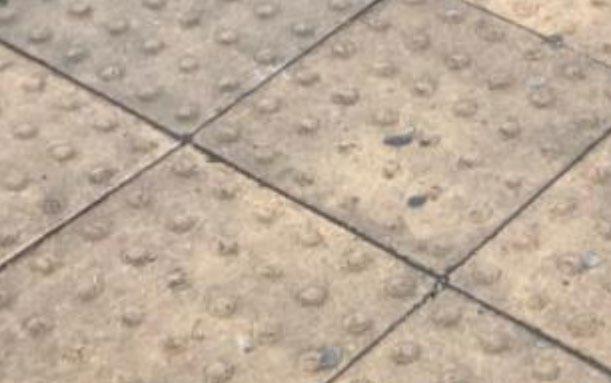
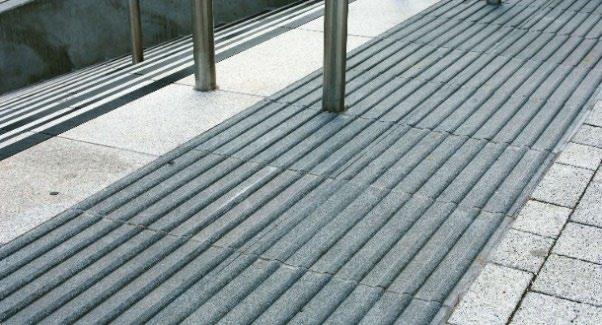
The distinction between ‘standard’ 63 and tactile paving materials helps visually impaired people to understand where they are in the public realm, where crossings are, whether these are controlled or not, and whether there is a change in surface, activity, or a specific hazard that they need to be aware of.
A distinct tonal contrast between the footway and carriageway surfaces, and access points between them, can also increase the accessibility of the public realm for neurodiverse people and those with dementia, as well as the visually impaired.
Whilst tactile paving typically delineates the edge of a particular space or level change, ‘tails’, also known as ‘stems’, or ‘Lshaped’ configurations, are used to indicate to people moving along the pavement the location of crossing points to their side.
The provision of the right type of tactile paving to aid accessibility is a fundamental requirement of any public realm scheme, with consistency key to ensuring accessibility in maintained across London. Worn and inconsistent use of tactile paving is confusing to users and poses safety concerns.
Metal studs have in the past been used in place of tactile paving slabs, however, these can become slippery when wet, are generally more painful for people with sensitive feet and wheelchair users, and heat up on hot days becoming painful for dogs’ feet.
Stick-down style tactile paving used as a temporary measure is prone to damage and wear.
Whilst the Department for Transport (DfT) guidance on tactile paving recommends use of red blister paving, with exceptions made in heritage areas, red blister paving is not proposed to be used in Westminster; 78% of the city is covered by Conservation Area, and the use of different materials in the remaining 12% of the city would result in an incoherent pattern of use.
Tactile Paving Guidance
A. The provision of the right type of tactile paving to aid accessibility is a fundamental requirement of any public realm scheme.
B. Tactile paving should be applied consistently.
C. Tactile paving should meet DfT standards.
D. Blister paving should be used to indicate the location of controlled and uncontrolled crossing points. This includes both where the footway has been dropped flush with the carriageway, and where the carriageway has been raised to the footway level.
E. ‘Tails’ should be used to indicate the location of controlled-crossing points to people moving along the pavement. These must use the same, recognisable form of tactile paving, as the feature they are leading people to.
F. Tactile paving at uncontrolled crossing points should be buff, or another colour that provides a clear colour contrast with the surrounding footway and the road.
G. Grey tactile paving should not be used where it does not contrast with the surrounding area.
H. Dark colours are unlikely to comply with our public commitment to make Westminster dementia-friendly.
I. Some relaxation of the colour requirements may be acceptable in conservation areas or in the vicinity of a listed building, in discussion with local groups of vision impaired people, mobility specialists, and the council’s conservation specialists. In these limited circumstances only, the tactile surface may be provided in a colour that is in keeping with the surrounding material.
J. Bespoke tactile paving designs, including the use of metal studs, will generally not be supported.
K. Tactile paving should be retrofitted into existing schemes whenever opportunities arise.
L. The preference is for permanent, rather than temporary “stick-down” paving.
M. Corduroy paving should be used to warn of hazards such as the top and bottom of steps, where it should extend across the full width of the steps.
63 In this case “standard” refers to the majority paving type
N. Corduroy warning of steps should be placed sufficiently in advance of the steps to give time for people to adjust their steps and not miss the warning.
O. Dedicated shared spaces for pedestrians and cyclists should be clearly demarcated with material changes at their start and end, as well as along the length of the track.
Material selection should follow BS EN 15209 Tactile paving surface indicators produced from concrete, clay and stone. This should be applied alongside the Inclusive Mobility Guidance on the use of tactile surfaces by the Department for Transport.
See The Department for Transport (DfT) published detailed ‘Guidance on the Use of Tactile Paving Surfaces’ for further information.
See TfL’s 2019 Streetscape Guidance for evidence-based examples of the use of tactile paving.
Carbon Reduction
Considerations to maximise carbon reduction:
• Challenge the need for intervention
• Consider alternative approaches to achieving the desired outcomes
• Maximise the use of existing assets
• Design in low carbon materials and operating models
• Minimise resource consumption
• Embrace new technologies
• Eliminate waste
Through specification based on suitable technical properties, modern production, for example, splitting rather than machine cutting of materials, and construction methods to ensure only the correct amount is extracted, produced, and installed to reduce the need for amendments on-site, which minimises disruption, carbon, and pollution and waste of materials.
Material Selection for Carbon Reduction Guidance:

A. A reduction in carbon must be prioritised in line with the carbon management hierarchy set out within the City Council’s Climate Emergency Action Plan.
B. Careful consideration must be given to the choice, sourcing, delivery, installation impact, operation, cleansing, maintenance, and lifespan, including reuse of paving materials.
C. Carbon considerations must include the product’s procurement, installation, replacement, and maintenance throughout the life of a given scheme.
D. Exceeding minimum carbon performance targets will be highly commended, especially through using low-carbon materials and suppliers who provide products with improved environmental performance.
E. A simple and durable selection of footway materials in standard sizes should be utilised.
F. Designers must demonstrate efforts to minimise carbon emissions.
G. Reduction or elimination of material usage should be considered as the first step of the waste and carbon reduction hierarchies.
H. Building less, building clever and building efficiently (maximising re-use) should be implemented once building nothing has been considered.
I. Material choices should respond to climate change.
J. Materials used should be low carbon concrete, granite, Yorkstone or asphalt or equivalent low carbon materials approved by the City Council.
K. Carbon-intensive materials should be avoided, reduced, or substituted.
L. Use of paving materials which are low carbon, sustainable, reliable, and easily sourced from ethical and sustainable sources are preferred.
M. Materials, and their installation, and associated practices, must meet environmental performance requirements set by the City Council, adopted from Publicly Accessible Specification (PAS) 2080.
N. Carriageway materials should contain at least 50% recycled materials.
O. Design and construction processes should incorporate strategies for disassembly and other circular economy principles such as reuse, reduce, and recycle.
P. The long-term health of the asset must be ensured to minimise repairs and the carbon impact from repair and maintenance activity.
Q. In line with the City Council’s current practices, the carbon impact, and monetary terms for the whole expected life of public realm designs should be assessed using industry standard assessment tools to ensure that sustainability has been genuinely addressed in the design
Material Types
The following are the main materials proposed to be implemented in new public realm schemes. Practitioners should refer to the Materials Palette Matrix to find further details such as their technical specifications, preferred locations, and other fundamental points to consider when selecting materials for each scheme.
Historical context
The prevalent historic paving stone in Westminster is carboniferous sedimentary rock from the English Pennines. The most common are tight-grained blue/grey and buff sandstone from Lancashire, Yorkshire, and other UK counties, collectively often called Yorkstone (see Figure 55). Until the nineteenth century paving in Westminster used large format slabs, typically two feet in width by three feet or random length, many examples of which remain.
Granite cobbled streets, typical of Victorian London, also remain in various streets throughout Westminster, most notably in mews, and on other roads that have not required to be resurfaced in asphalt (see Figure 56).
Where historic paving survives, it is likely to make a significant contribution to the character of the public realm, however the use of cobble stones and other historic materials in new schemes requires careful consideration as they may detrimentally impact on accessibility – being uncomfortable for wheelchair users and a hazard for cane users, and improvements can be made to original surfaces to aid accessibility and maintenance.
Avoiding small unit paving in new schemes enables safer and easier access for many groups who may find it challenging to use uneven surfaces due to temporary or permanent physical/mental conditions and those or using pushchairs, strollers, high-heels, or luggage.
From the early twentieth century the concrete paving flag, or ‘Artificial Stone Paving’ (ASP), was increasingly used (see Figure 57). Whilst these have become the most ubiquitous paving material, their use can be carbon intensive and therefore detrimental to the environment. Use of standard / carbon-intensive ASP is not encouraged where there are more environmentally sound materials available, which may include low carbon specification ASP, to meet the need.
Cast iron coal hole covers are a distinctive feature of pavements throughout Westminster in areas of remnant stone paving (see Figure 58). The covers are typically 12 to 14 inches in diameter and are often decorated with intricate patterns. They are of historic interest and contribute to the character of the city. Most iron works in the public realm are owned and therefore maintained by the utility companies. Where the highway authority replaces the utility company standard cover with a bespoke inset cover, the highway authority assumes the maintenance responsibility for that cover. For more information on drain and inspection covers see Services and Utilities Guidance below.
Historic Materials Guidance:
A. Historic paving materials, including setts, natural stone slabs and coal hole covers, should be retained and where necessary repaired with matching materials.
B. Conservation requirements will demand that cobbles, granite setts or small-set blocks be kept in some historic locations.
C. The use of new cobble setts or small-set cropped paving is to be avoided unless there is a historic context.
D. Where it is to be used in a historic context any new small unit paving should be specified to maximise accessibility.
E. Restoration of cobbled stone pointing can help improve accessibility in historic areas.
F. Regular restoration of the cobble points can help to ensure that the surface remains as even as possible.
G. Accessible routes should be provided through cobbled areas.
H. Causeways of more regular granite setts may be inserted to ensure a continuous network of routes for people with differing access requirements.
I. Such areas must not present high slippage risks in wet conditions or due to wear.
J. In heritage settings new paving should be matched to historical paving and should be laid in a traditional pattern.
K. Historical materials and high-quality new paving should be matched with care and, as far as it is practical, should replicate traditional laying methods.
L. Items of character, such as mounting blocks from the Era of the Horse and coal hole covers (see Figure 58) from the Age of Coal Fires, should be retained as historic features.
Coal Hole Guidance
A. Where cast iron coal hole covers survive, they should be preserved in situ and should dictate the coursing of the surrounding paving.
B. Generally, these are characterful features in conservation areas that should be retained and replaced in replica when failed and if part of the vault of a listed building must not be removed unless authorised by a prior listed building consent
C. Non-historic coal hole covers can provide an opportunity to install public art, although this will be reviewed on a caseby-case basis.

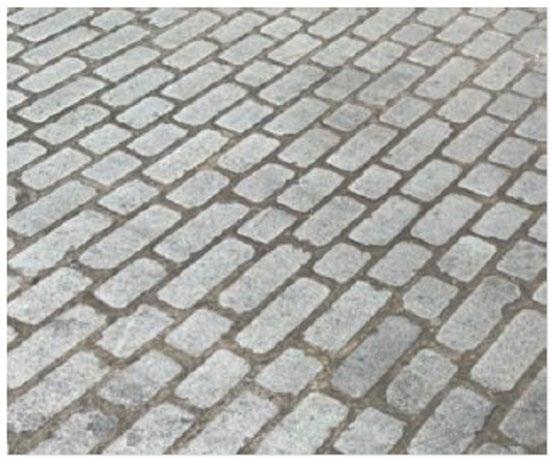
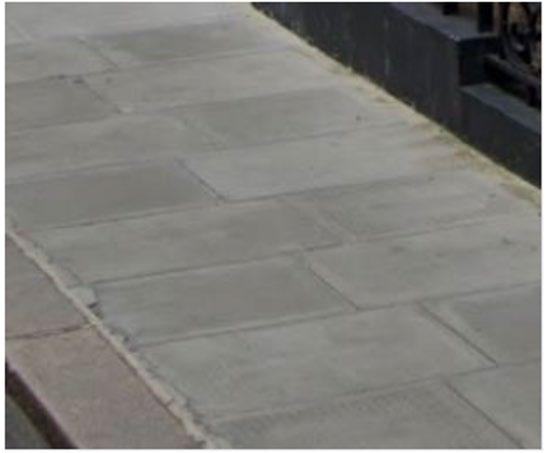
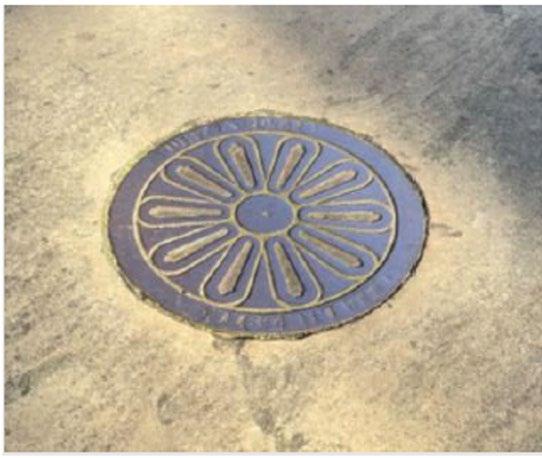
Yorkstone / Sandstone
Yorkstone is a carboniferous sandstone sedimentary rock found in the English Pennines. Sandstones vary in strength, water absorption and other desirable properties, so it is essential to assess each sandstone in its own right.
Guidance:
A. The preferred location for using sandstones, is in heritage areas with high pedestrian footfall.
B. The use of sandstone should be limited in areas with food establishments and markets to minimise the risk of staining the sandstone when exposed to grease.
C. Use of sandstone slabs should be avoided in loading bays as they may break under considerable load.
Granite and Basalt
Granites and basalts are igneous rocks formed through the cooling of molten rock. The city has had prolonged success with both the use of mixtures of colour and the utilisation of darker greys and black in areas where paving is significantly prone to staining.
Basalt and granite cobbles have been used in streets with markets and other areas such as the West End / Leicester Square, where the public uses the space for food consumption and socialising. Granite slabs and setts provide the most durable surface material and can withstand intense wear and hot or pressure washing. Both setts and cobbles have performed exceptionally well under traffic loading when designed correctly
Granite Guidance
A. Granite setts should be considered on carriageways and footways with high footfall and where the public uses the space for food and drink consumption
B. Darker setts and cobbles maybe used in areas where the risk of staining through grease and oil is elevated, such as parking bays and loading bays
C. Granite setts can also be used in trafficked areas such as on speed tables or vehicular crossovers, due to their strength but in high trafficked areas they are not favoured due to the turning movements of vehicles causing breaks in joints and the disruption to the network for replacement.
Other Natural Stones
Porphyry, similar to Granites & Basalts, are igneous rocks formed by cooling solid hot rock. Whilst the benefits of this material are still being assessed, there are currently no identified benefits in using porphyry over other materials and therefore its use will not generally be supported in Westminster.
Black/Dark Grey Sandstones and Mudstones such as Caithness are sedimentary rocks from the Devonian period. Caithness has been applied in Hanover Square. Although relatively new materials deployed in Westminster, these natural stones have desirable properties, such as being strong and hardwearing, which should be maximised through good procurement, design, engineering and construction.
Concrete Materials
Concrete Flags, also known as Artificial Stone Paving (ASP), are a staple of the streetscape in London. They have been successfully introduced in a range of areas. However, they should be avoided or designed to the required standard in locations with expected vehicle overruns to avoid extensive cracking.
Coloured Concrete Flags replicating natural stone products and small elements are undesirable based on appearance and functionality. These types of elemental paving are not deemed fit for Westminster’s streetscape, being hard to source and maintain.
Coloured Flag Guidance:
A. Use of coloured concrete flags is not generally supported in Westminster.
Permeable Paving / Sustainability Standards
Certain materials, such as pervious/porous or permeable paving, and/or paving laid with porous spacing (i.e. space around paving slabs to allow for drainage) support principles associated with sustainable urban drainage as they allow infiltration, water retention and/or attenuation. Special consideration should be given to such materials and their requirements followed to ensure the good functioning of the proposed sub-surface drainage system and avoid clogging.
Appropriate maintenance schedules are expected to be provided by developers, stipulating the tasks and frequencies over the expected lifespan of these materials.
Materials Sustainability Guidance:
A. All schemes must demonstrate the highest sustainability standards during the whole-life span of projects and must consider and, where possible, include the introduction of trees and green infrastructure in combination with Sustainable Urban Drainage Systems (SuDS) for better management of water resources and rainwater run-off.
B. Suitable surface water drainage methods must be designed into all public realm schemes.
C. Where SuDS are proposed, surrounding areas should also be adequately designed and constructed, for example, with inclines to channel water into proposed features. This will maximise the success of these features from a functionality and flood risk reduction standpoint to ensure that the quantified benefits are reaped.
Heat Retention
Reflective materials can reduce the ‘heat island effect’, by reflecting rather than absorbing the sun’s heat. The replacement of hard surfaced areas with new grassed or planted areas can also contribute to heat reduction and has other environment benefits 64
D. Designs must consider use of materials to address urban heat retention and deliver a safer and more pleasant environment.
E. Potential for greening of underutilised footway space should be explored.
64 The Healthy Streets for London Guidance
This approach should complement shade elements to improve the experience in resting areas. [see Chapter 4.4 Microclimate].
Tree Pit materials
The surface materials covering tree pits are generally contiguous with the footway, and special consideration is therefore required to ensure that these surfaces perform successfully within the public realm.
Selecting the most appropriate surface materials for trees located in hard surfaces, such as those on footways, highway build outs and in public realm schemes, requires consideration of the needs of the trees, (such as permeability to air and water), highways requirements (for example, providing safe level surfaces), maintenance and installation considerations (including lifespan, sustainability, cost, and ease of installation), and townscape considerations, (including the design intent of particular projects or public realm schemes).
The most appropriate surfacing varies according to the trees and site requirements. The optimum surfacing for a given location may also change over time, as the trees grow and mature. Consideration should be given to the changing future requirements for tree pit surfaces when preparing landscape management plans.
1. Criteria for the selection of surface materials
The criteria for selecting suitable materials can be broadly divided into:
• Tree criteria, such as permeability to air and water, flexibility of material, risk of tree damage during installation and suitability for installation for new trees or established trees.
• Site criteria, such as tolerance to pedestrian or vehicular traffic, maintenance, weeding and street cleaning considerations, townscape and aesthetic issues and community engagement.
• Installation and maintenance criteria, such as level of experience/competence required to correctly install and maintain the surfacing, sustainability and expected lifespan of material.
Trees Appendix (Figure 59) below sets out a list of considerations and a matrix of selection criteria for surfacing around trees as suggested by the London Tree Officers Association (LTOA), in their publication Surface materials around trees in hard landscapes. It illustrates the wide variety of criteria which determine the best surface material for any given situation.
2. Available materials
The most common materials used around trees in hard landscapes in Westminster are:
• Soil
• Self-binding gravel
Other materials include:
• Resin-bound gravel
• Asphalt
• Rubber crumb
Rarely used materials include:
• Inorganic mulch/ materials
• Organic mulch
• Grilles – these can be particularly problematic for people using mobility aids such as sticks, canes, wheelchairs or wheeled walking frames, or for people with assistance dogs
A brief description of the benefits and limitations of these materials and their use in Westminster is set out at the Materials Palette in Appendix 2 of this SPD
Materials for New Trees
The standard specification for new trees planted in pavements is soil. This provides the trees with good conditions for establishment and is low cost, although the pits can become weedy and risk compaction in busier areas.
In commercial areas, areas of high footfall, or on narrow footways, where a more robust surface is required, self-binding gravel or permeable resin bound gravel should be used, according to the site requirements. This can be used to provide adequate pavement width and prevent compaction to tree roots. Inclusion of self-binding gravel in these locations allows the sufficient level footway width and Disability Discrimination Act compliance, without which tree planting would be precluded.
Highway build-outs provide the opportunity to plant larger trees in specially designed tree pits. For highway build-outs select self-binding gravel or permeable resin bound gravel, in line with safety audits and site criteria.
Bare soil is not usually an appropriate tree pit surface for large scale public realm and highways improvement schemes, as these interventions are usually designed to make public spaces more accessible and to cater for particular activities. The surface in these schemes needs to be level, firm, easy to maintain and provide suitable conditions for tree growth. Resin bound aggregate in suspended trays or modular tree grilles can meet these requirements, and provide aesthetically appropriate permeable surfacing. These schemes are subject to an internal Key Stage Review process in which the proposed surface materials around trees are considered by relevant officers, taking into account safety audits and the purpose and design criteria of the scheme.
Impermeable materials are not appropriate for newly planted trees.
Materials for Existing Trees
After a new tree has been planted in soil it is common for levels in the tree pit to settle naturally. Soil around new and existing trees can also become displaced or compacted by pedestrian movement or vehicle overrun.
Materials are installed around existing trees to maintain the highway in a good and safe condition, either as reactive works or as part of planned highways maintenance. Different materials are selected according to the criteria outlined above.
Soil, mulch, or loose gravel are not selected to install around existing trees due to the tendency of these materials to become displaced over the highway, and the enhanced maintenance and replacement regimes they require over other materials. Soil also has the propensity to become weedy. Grilles are not suitable for retrofitting around existing trees.
Self-binding material such as Breedon gravel or hoggin are usually selected where footway widths permit and/or where footfall is relatively low. These materials are permeable, help to suppress weed growth and provide a neat appearance, and are relatively easy to remove and can be replaced with topsoil by community gardeners.
Where footways are too narrow for self-binding materials, or in busy commercial and retail areas, select permeable resin bound gravel as a preference over non- permeable surfacing materials. Hard surfacing such as resin bound gravel is selected in busy commercial and retail areas, and in locations where footways are narrow, in order that the tree pit can serve as part of the footway.
Where paving is disrupted or root plates have caused distortion of the surface, select resin bound gravel or rubber crumb with a percentage of gravel as a preference over non-permeable surfacing.
Flexible surfacing such as rubber crumb with some gravel content is used in particular instances, for example where roots have caused displacement of the footway.
Asphalt is sometimes used in tree pits but is more commonly used to repair displaced surfacing surrounding the tree pits. Where trees are well established and where required for consistency of surfacing, install asphalt as a low-cost solution or temporary solution, only after permeable solutions have been ruled out.
Considerations for Selection, Installation, and Maintenance of Surface Materials for Trees
The practical, environmental, aesthetic, and financial considerations which are taken into account when surface materials are installed around trees include:
Age, species and condition of tree; Pedestrian/vehicular traffic levels; Width of footway; Cost of installation;
Cost and frequency of maintenance;
Skill level required for installation and maintenance; Predicted lifespan of material; Sustainability of source; Permeability of proposed material;
Site topography;
Design, townscape and aesthetic issues;
Street cleaning; Availability of materials.
Selection criteria matrix
The matrix below sets out the selection criteria for these surfaces as suggested by the London Tree Officers Association (LTOA). The designations of high medium and low are all relative, and the colour coding suggests green is a good option, and red is not so good.
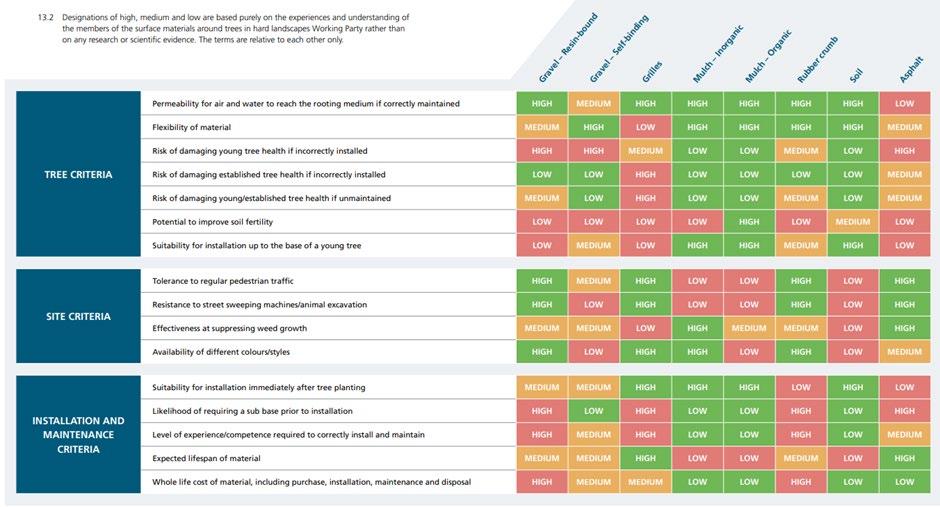
Materials Sourcing
There is a need to maintain a manageable palette of materials to enable stocks to be held for urgent repair and maintenance response purposes, and for the City Council to satisfy itself that any materials used will still be available for maintenance and repair in the longer term.
Damage to materials with a long production time or logistics chain will result in temporary patching until proper replacements can be sourced and put in place. Paving materials with reliable supply and that are easily sourced from local suppliers is preferred.
Ethical sourcing places a responsibility on designers and contractors to ensure that materials used are supplied in line with minimum standards of labour practices, respecting human rights, whilst the purchase of local materials can help reduce transport and related environmental impacts.
Careful consideration should be given to any material coming in from distant and remote places where the stability of the source and the commitment to the environment may not align with the city’s overarching principles.
Material Sourcing and Transporting Guidance:
A. The carbon impact of different modes of transport and fuel types required to transport materials and operators should be assessed, especially where heavy vehicles/machinery are not likely to be required.
B. Opportunities should be taken to reduce trips through consolidation and efficient planning of logistics.
C. Opportunities should be taken to reuse and source materials locally.
D. Supply of materials and scheme transportation should encourage the use of sustainable operational models, sustainable fuels, sustainable transport to and from site for site operators, and limit the usage to what is strictly required.
E. The weight of transported material should be reduced as far as practicable - with reuse being promoted, through careful specification as well as buying with takeback agreements.
F. All materials specified must come from ethical sources in line with Westminster’s ‘Responsible Procurement and Commissioning Strategy’2022-2026 and avoid unacceptable practices such as child labour.
G. Materials should be locally sourced, from reliable suppliers.
H. Consideration must be given to the sourcing and timescales for delivery of replacement materials should they be needed in the future.
Paving materials should be obtained from reliable suppliers and sourced in preference order from:
I. UK manufacturers
J. Mainland Europe where commitments to Climate Change and reductions in carbon dioxide and greenhouse gas emissions are a shared policy within the UK and the City of Westminster
A. Using the most up-to-date guidance, materials must be kept to the minimum required volumes, making effective use of resources, and reducing waste.
B. New paving materials outside of the existing pallet are likely to be refused.
C. Surplus surfacing materials should be stored by third parties to ensure that future paving repairs can be consistently matched.
D. Developers will be expected to pay commuted sums to cover the cost of additional replacement materials.
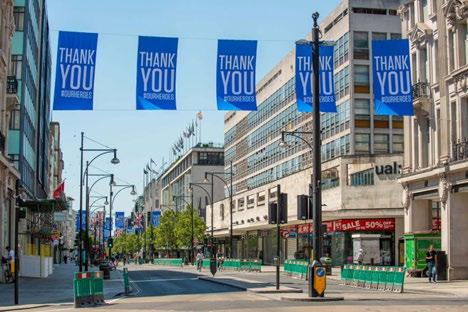
King Street, St. James’s Westminster, underwent a 6-week repair and replacement of the footpath and kerbs. The full life cycle impacts of design and delivery were taken into account, to reduce embodied carbon. To minimise carbon footprint, the scheme used recycled materials, reduced consumption of natural resources, and made use of electric rather than diesel vehicles.
Materials used included recycled asphalt, and low carbon concrete for the kerbing and footway, with reduced slab thickness laid, reducing the amount of concrete used. https://www.fmconway.co.uk/case-studies/king-street
Materials Cleansing and Maintenance
Ease of maintenance of paving schemes not only ensures longevity but also reduces carbon and enables functionality to be retained. This is particularly relevant in areas of intense use where spillage is likely to occur, for instance, outside food and drink premises, street markets, and areas of waste disposal and collection.
Consideration of ease and efficiency of cleansing of materials must be factored into public realm designs from the start, and is an important factor when choosing materials, for example to facilitate removal of chewing gum using high-pressure water jets.
Very intense cleansing regimes and pressure washing may not be suitable for all materials.

